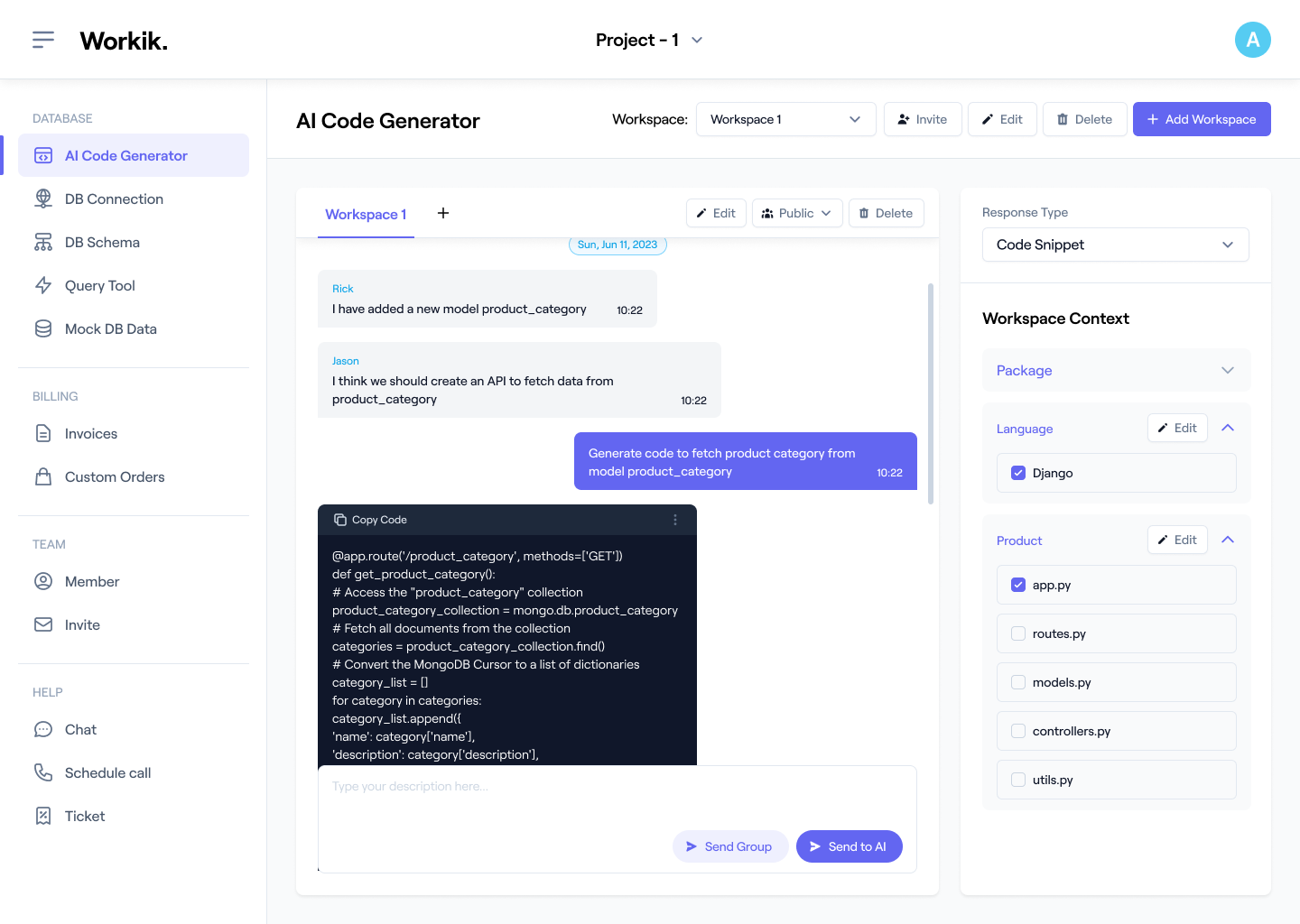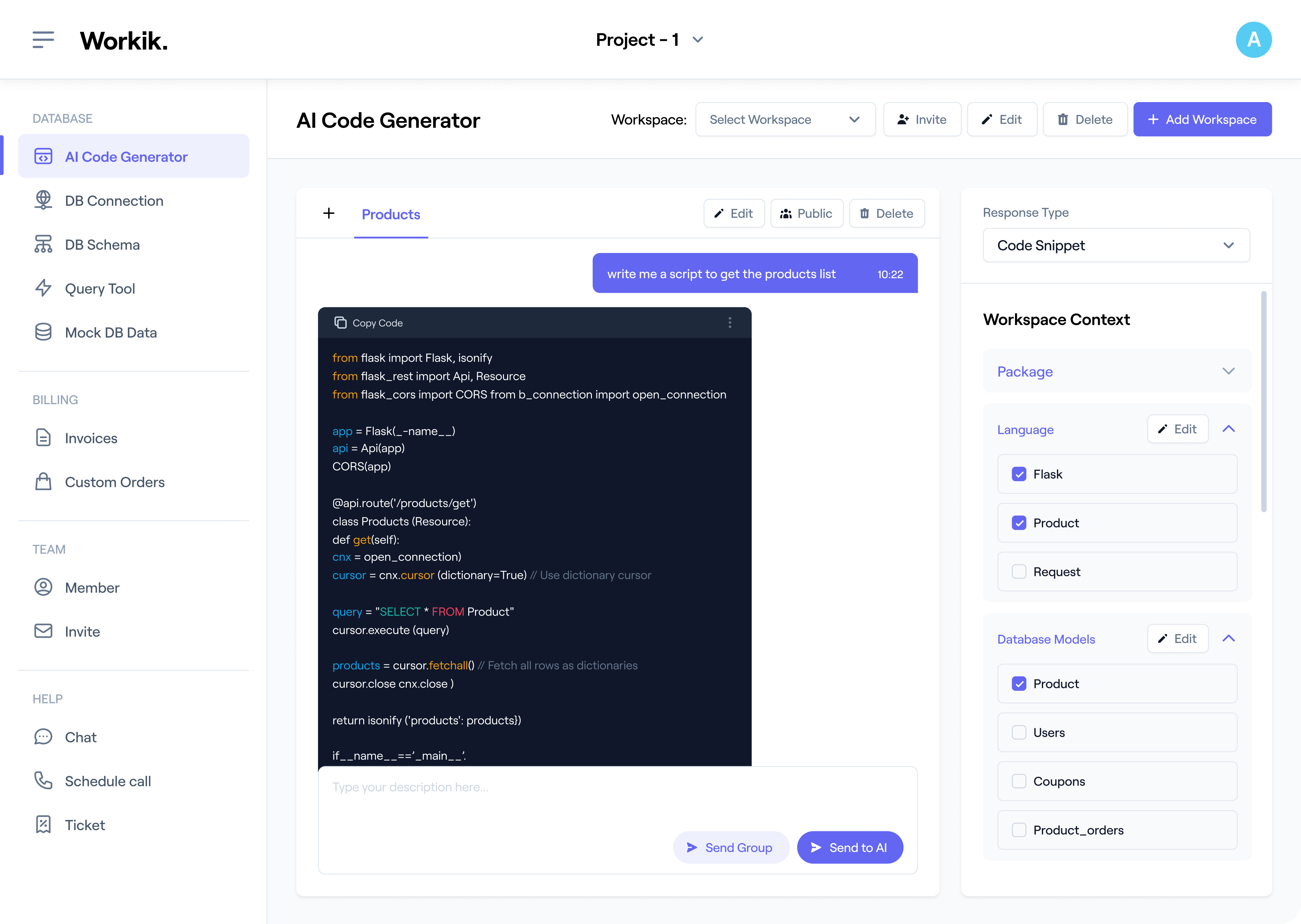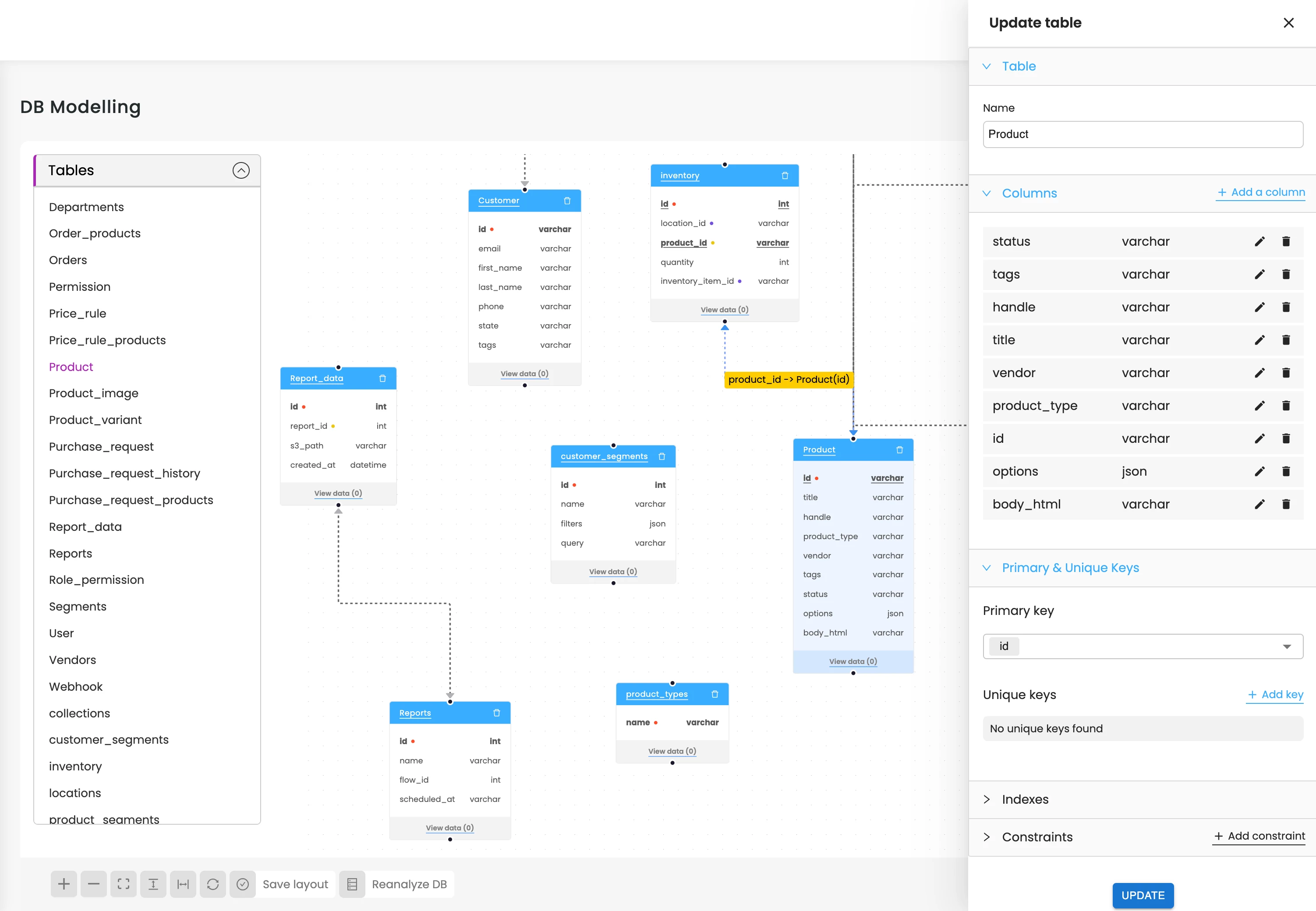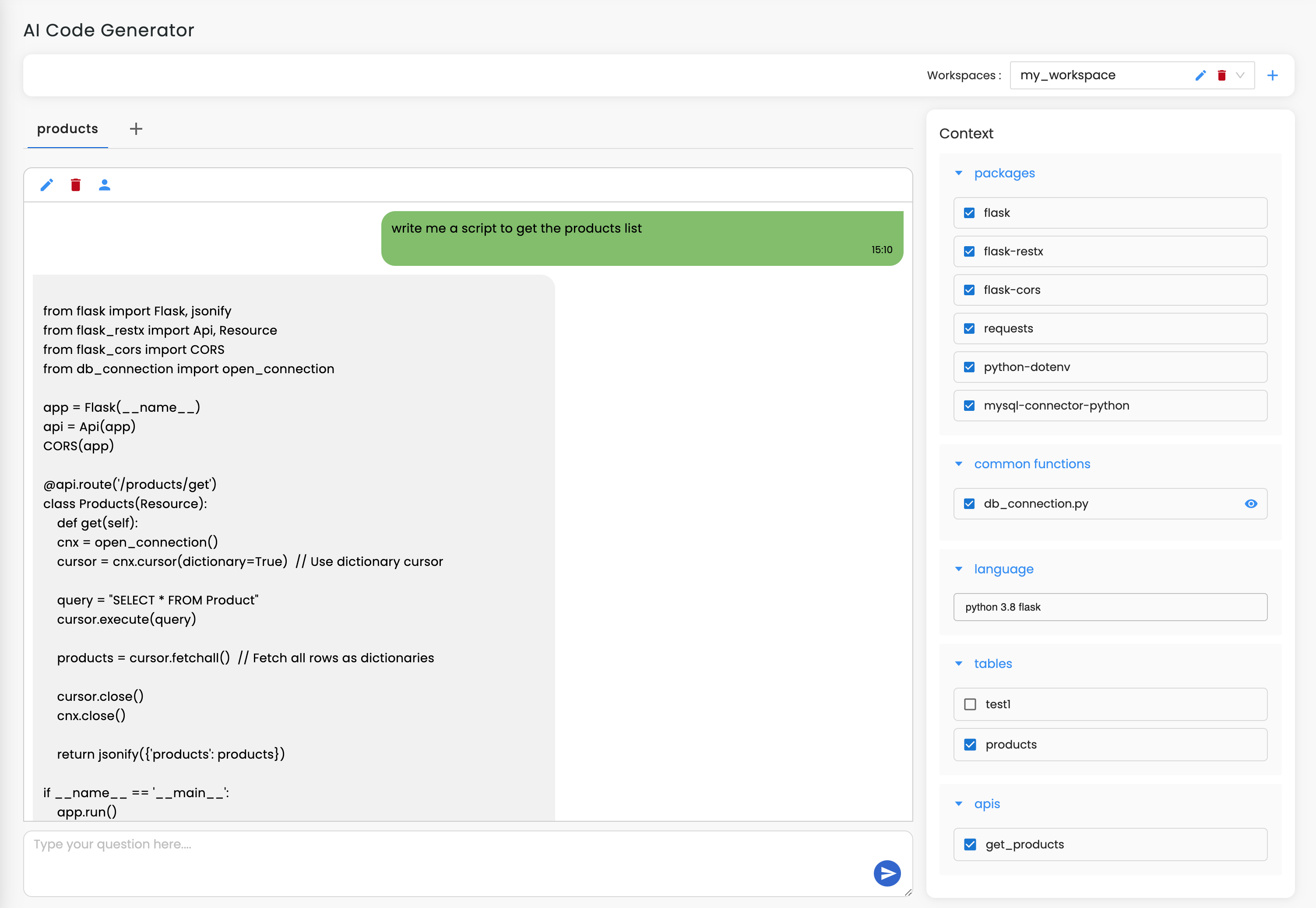
Join our community to see how developers are using Workik AI everyday.
Features

Instant Query Tuning
Use AI to identify inefficient joins in your SQL queries and refactor them for performance improvement.

Dynamic Indexing Suggestions
Use AI with MySQL Performance Schema and SQL Server tools to optimize indexing and fix bottlenecks

Effortless Query Refactoring
Refactor subqueries into CTEs or window functions for enhanced performance and readability.

Rapid Query Performance Analysis
Visualize and resolve slow queries with AI and tools like EXPLAIN ANALYZE or Query Analyzer.
How it works
Sign up on Workik using Google or manually in seconds, then set up your SQL optimization project.
Connect repositories from GitHub, GitLab, or Bitbucket. Define your database type—MySQL, PostgreSQL, or SQL Server—and upload schema details to enable precise AI query optimization.
Optimize SQL queries, debug issues, improve indexing, and refactor subqueries. AI tests execution paths, detects bottlenecks, and suggests improvements for faster performance.
Share AI-optimized queries with your team for feedback. Iterate to enhance indexing, reduce execution time, and ensure your database performs efficiently under heavy loads.


Expand
.png)
.png)
Expand


Expand


Expand


Expand


Expand


Expand


TESTIMONIALS
Real Stories, Real Results with Workik
Workik AI saved hours by pinpointing bottlenecks and optimizing indexing. Instant performance boost!

John Matthews
Senior Database Administrator
Workik AI drastically improved query speed and made SQL optimization effortless. A must-have for any dev!

Emily Carter
Full-Stack Developer
SQL tuning has never been this efficient! Workik transformed slow queries into lightning-fast operations!

Rohan Singh
Backend Engineer
What are the popular use cases of Workik's AI for SQL query optimization?


Some popular use cases of Workik's AI-powered SQL query optimization include but are not limited to:
* Optimize complex SQL queries in databases like MySQL, PostgreSQL, and SQL Server.
* Automate index creation and tuning for large tables, ensuring minimal query bottlenecks.
* Refactor subqueries and joins into more efficient structures like Common Table Expressions (CTEs) or window functions.
* Debug and test SQL queries under different load conditions to ensure optimal performance during high traffic.
* Generate optimized queries for data aggregation and retrieval in real-time analytics or reporting applications.
What kind of context can I add in Workik AI related to SQL query optimization?


Setting context in Workik is optional but enhances AI-generated SQL query optimizations. Here are the types of context you can add for SQL optimization:
* Database types (e.g., MySQL, PostgreSQL, SQL Server)
* Codebase files (import SQL queries and scripts from GitHub, GitLab, or Bitbucket to sync with your project)
* Schema details (upload database schemas for more precise indexing and query optimization)
* Frameworks (e.g., Hibernate for Java, Entity Framework for .NET)
* API blueprints (e.g., Swagger or Postman to handle SQL queries within API request/response workflows)
How does Workik AI handle optimization for complex, multi-database systems?


If your application uses MySQL for transactions and PostgreSQL for analytics, Workik AI adjusts query structures and indexing strategies based on the unique needs of each system. This is crucial for distributed applications or microservices that depend on diverse databases for different workloads.
How can Workik AI help with query optimization in cloud environments?


Workik AI optimizes SQL queries for AWS RDS or Azure SQL Database, accounting for factors such as network latency, I/O performance, and scalability. It provides cloud-native solutions like query batching, read replicas, and sharding to boost performance while reducing resource costs, ensuring efficiency as your application scales.
How does Workik optimize indexing for better query performance?


Workik’s AI analyzes your schema and query patterns to suggest optimal indexing strategies, like B-tree or GIN indexes, improving read-heavy query performance. It also recommends composite or partial indexing for large datasets, balancing storage and speed.
Can Workik optimize complex queries for high-traffic environments?


Yes, Workik’s AI optimizes for stress-testing queries under different loads. It enhances batch processing for large datasets, ensuring low latency and efficient resource usage in real-time systems.
How does Workik AI assist with SQL query debugging?


Workik AI simplifies SQL query debugging by automatically detecting errors, performance bottlenecks, and inefficient joins. It highlights problematic areas in the query, suggests fixes, and tests solutions in real-time, ensuring your queries run smoothly without manual intervention.
Generate Code For Free

SQL Query: Question and Answer
SQL query optimization is the process of enhancing the performance of SQL queries to ensure they execute efficiently and retrieve data faster. This involves techniques such as improving indexing strategies, refactoring queries, optimizing joins, and adjusting database schemas to reduce execution time and resource consumption. The goal is to minimize query bottlenecks and ensure the database handles large datasets and complex queries efficiently.
Popular frameworks and tools for SQL query optimization include:
Query Analysis:
EXPLAIN (MySQL, PostgreSQL), Query Store (SQL Server)
Indexing:
B-tree (MySQL), GIN (PostgreSQL), Clustered/Non-clustered Indexes (SQL Server)
Execution Plans:
EXPLAIN ANALYZE (PostgreSQL), Query Plans (SQL Server)
Monitoring:
pg_stat_statements (PostgreSQL), Performance Schema (MySQL), SQL Server Profiler
Optimization Tools:
Database Engine Tuning Advisor (SQL Server), SQL Tuning Advisor (Oracle)
Popular use cases for SQL query optimization include:
Speeding Up Reporting Queries:
Optimize complex analytical queries for real-time reporting systems.
Handling High Traffic:
Ensure queries are optimized for databases in high-traffic environments to handle millions of records efficiently.
Minimizing Resource Consumption:
Optimize resource-heavy queries, ensuring they consume less CPU and memory, especially in cloud environments.
Improving Data Aggregation:
Enhance performance of data aggregation queries in business intelligence tools.
Scaling Databases:
As data grows, optimize queries for large datasets to maintain high performance.
Professionals skilled in SQL query optimization can pursue roles such as Database Administrator, Data Engineer, Backend Developer, Business Intelligence Analyst, DevOps Engineer, Systems Architect, and Cloud Architect.
Workik AI provides powerful features for SQL query optimization, including:
Instant Query Optimization:
Use AI to optimize complex SQL queries, improving performance and reducing execution time.
Indexing Recommendations:
Receive AI-driven suggestions for indexing strategies based on schema and query patterns.
Cross-Platform Query Support:
Optimize SQL queries for multiple databases, including MySQL, PostgreSQL, and SQL Server.
Refactor Queries:
AI refactors inefficient subqueries and joins into optimized structures like CTEs or window functions.
Testing and Validation:
Simulate high-traffic environments to stress-test queries and ensure stable performance under heavy loads.
Visualization:
Generate query execution plans and visualize performance bottlenecks for easier debugging and optimization.
Documentation:
Create document query optimization strategies and performance improvements for better collaboration and clarity.
Explore more on Workik
Get in touch
Don't miss any updates of our product.
© Workik Inc. 2025 All rights reserved.

